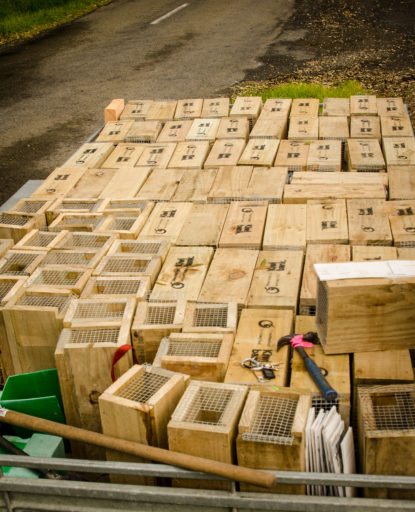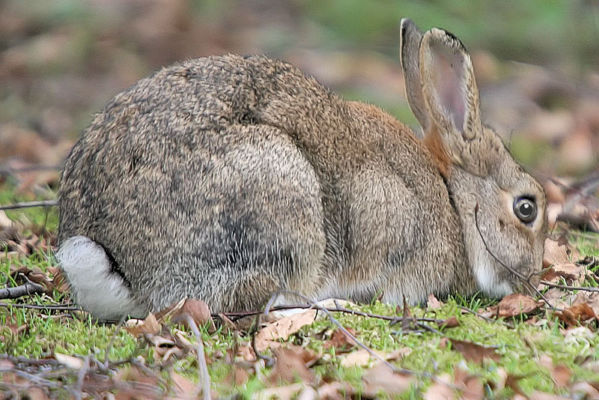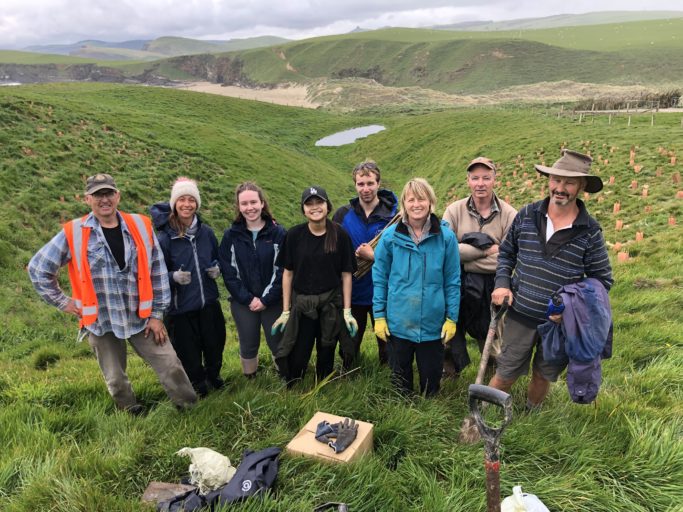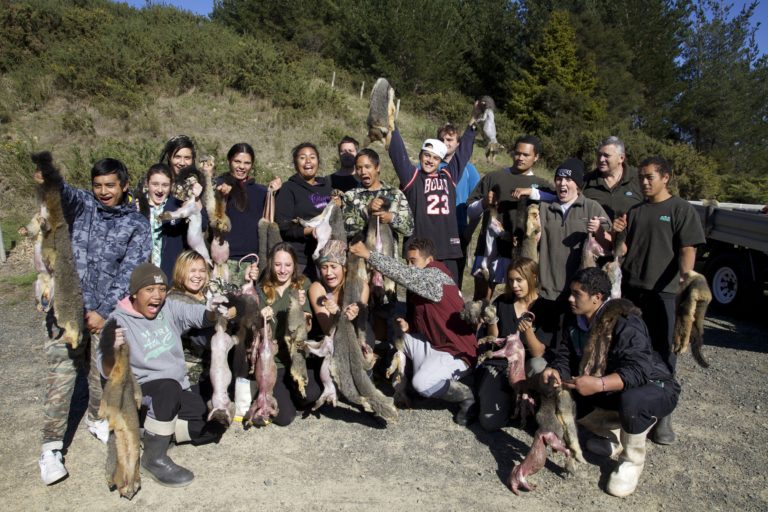Achieving Predator Free 2050 goals will take more than just a scaling-up of eradication efforts according to researchers Duane Peltzer et al from Landcare Research (Lincoln) and the University of Canterbury. They look beyond economic and technological feasibility to identify the key impediments we need to overcome, in a paper recently published in the Journal of the Royal Society of New Zealand.
“We suggest that achieving this goal is not a simple ‘scaling-up’ of current eradication efforts, but requires enduring co-ordination and integration of research, management and societal elements if a predator-free goal is to become a reality. We highlight four interlinked issues that must be addressed to accomplish a predator-free New Zealand:
- improved ecological understanding of interactive effects;
- refinement and development of operational methods;
- overcoming social and bioethical challenges; and
- improving governance and partnerships with Māori.

According to the paper’s authors, few places in the world are as ‘invaded’ as New Zealand.
“Overall, the proportion of naturalised non-native species in New Zealand exceeds nearly all other countries or regions except Hawai’i. If PFNZ 2050 becomes a reality, the technological and social advances required will have major implications for improving large-scale conservation and pest management worldwide and over the long-term.”
“Addressing these challenges is a widespread and urgent issue given the need to apply ecological understanding to develop improved policy and management of biological invaders and the species or ecosystems affected by invasive species and their management.”
Firstly, the authors look at interactive ecological effects.
“Invasive non-native predator species (hereafter, ‘predators’) can have direct negative impacts on their prey but can also exert important indirect effects such as vectoring diseases or disrupting mutualisms. For example, the Australian brushtail possum is thought to increase tree mortality and drive population-level dieback of palatable native species in some areas through consumption of canopy foliage, can act as a vector for bovine tuberculosis (TB) transmission, and is a predator of native birds.”
“The proximate goal of management to remove predators is clear, but the ultimate outcome and motivation of management is to restore biodiversity, reduce risks of disease, or renew ecological or ecosystem processes, which are less well articulated outcomes.”
The removal of mammalian predators can have complex effects in ecosystems
“PFNZ 2050 selectively removes predators such as mustelids, possums and rats across different systems, but their removal may have contrasting outcomes for other species including non-native mammals, native birds or other taxa. For example, ‘mesopredator release’ (i.e. increases in the abundance of smaller predators or omnivores following predator control) can negatively affect prey species, although the strength and generality of this effect is uncertain. Regardless of whether mesopredator release per se follows eradication, the removal of selected mammalian predators highlights that the responses of other species such as mice, European hedgehogs, and feral cats, need to be considered in the context of predator eradication.”

“Removal of predators can also result in releases of herbivores, which in turn can alter plant community structure and composition. For example, reducing the abundance of mustelids and cats in a dry shrubland ecosystem (Alexandra) drove increases in non-native herbivores (European rabbits and hares) that in turn reduced grass productivity and shrub establishment. An unanticipated consequence of this herbivore-induced vegetation change was to create habitat less suitable for mice, thus releasing populations of native lizards and invertebrates from predation by mice.”
The second challenge we face is the need to refine and develop operational methods
“Pest or predator eradication has rapidly developed over the past two decades through refined management of environmental toxins or biocides, better spatial deployment or targeting of control efforts, and improved methods for detecting target populations and the effectiveness of eradication. Rapid progress in predator control has also been made through innovation of novel traps, improvements in surveillance and detection methods to understand when and where to deploy management, and more network-enabled systems to generate data (e.g. networked sensors, webenabled tunnel traps).”
Eradication at larger spatial scales cannot be achieved solely through an expansion of current management approaches, the authors believe, but also relies on development or deployment of socially acceptable new methods or techniques, which itself is dynamic and interacts in complex ways across communities. Some potential future tools such as novel gene technologies, viral biological control and new toxins, will challenge public perception of what is acceptable.
“Given the scale, complexity and multiple species involved with PFNZ 2050, a combination of approaches is likely to be pursued including toxins, advances in detection and trapping or control technologies, or new genetic or biological tools. Furthermore, these methods are likely to be deployed in combination and in different ways to the status quo in order to achieve eradication at ever-larger spatial scales. In all cases, the translation from a new potentially effective tool to social acceptance of this combination of approaches goes far beyond simple ethics into stronger and sustained engagement within a social-ecological system.”
The benefits of achieving predator free goals need to be communicated well in order to engage society’s support and in order to communicate those benefits, they need to be monitored, measured and reported.
“One unequivocal benefit of predator eradication is for improving biodiversity, such as increasing the abundance of indigenous bird species. However, demonstrating benefits of predator eradication requires including response variables that capture how biodiversity or ecosystem functions change as a consequence of predator removal; in other words, management effectiveness of eradication.”
The key is to know what to measure and count.
“Beyond quantifying catch effort and predator numbers (i.e. direct costs of eradication management), a long-standing issue is what additional information and effort is needed to demonstrate management effectiveness and benefits? We anticipate that widening the measures of success would also capture unanticipated benefits or surprises of large-scale management efforts.”
It is also important to remember that predators aren’t the only cause of decline for our native species.
“Will PFNZ 2050 be a net benefit for native biodiversity? Undoubtedly yes, if perverse effects are avoided and management efforts are not diverted away from other drivers of decline. Ensuring management efforts are not diverted away from other activities such as habitat restoration relies on clear governance structures and co-ordination at the meso- and national scales; for example, by linking PFNZ 2050 with the ‘billion trees’ programme, which seeks to increase forest cover throughout NZ and will thus have consequences for habitat availability and quality. On the other hand, predator removal alone many not result in the expected benefits if it undermines other efforts or other major drivers of change are not also considered.”

Stressors or threats to native biodiversity, other than predators, include ecosystem changes, pollution, climate change, habitat fragmentation or exploitation.
“For example, Ruffell and Didham (2017) demonstrate for northern NZ that only a few bird species responded positively to intense predator control, and that this response was conditional on having sufficient forest cover (about 10%), suggesting that restoration of woody plant cover is needed for the benefits of predator control to be realised. Treating predator removal as the single or main driver of changes in diversity may be treating the symptoms rather than the causes of change in complex social-ecological systems (SES).”
Then there are societal considerations of eradication effort.
“Beyond understanding the biological system implications of large-scale predator management, complex social issues will also need to be addressed. For example, one potential conflict involves non-native species that are simultaneously valued and despised by different communities. Non-native predator species in NZ span the range from universally unwanted pests (e.g. rats, mustelids, possums, wasps) though to valued resources (cats, dogs, pigs) and even to legally protected (e.g. salmonid fish). Furthermore, non-native species such as pigs and deer have become culturally significant to Māori as a source of food.”

Eradication of invasive predators will require a sustained long-term effort and investment by diverse communities, with potential benefits including better mechanisms for conflict resolution or co-ordination among communities. Urban areas are also particularly challenging when it comes to eradication.
“Nowhere in the world have rats been eradicated from an urban area and if NZ can achieve this it will have major benefits for urban health worldwide.”
An unresolved issue is what level of community acceptance is needed to allow effective eradication?
“Even if a small minority of the population object, what then is the likelihood of eradication success? Social engagement or considerations of impacts are non-trivial given that NZ is highly urbanised (i.e. in 2014, 72% of the population live in centres with >30,000 people). Accomplishing the PFNZ 2050 goal thus requires widespread engagement, and appropriate methods to consider social impacts of management activities, particularly in urban areas where alternative approaches to aerial poison drops will need to be developed. Furthermore, there is also a widespread move towards greater support for, and reliance on, community partnerships to accomplish conservation goals that rely on voluntary public interest in pest control, management or restoration activities.”
External communities also shape acceptable management practices – for example the growing number of international tourists visiting New Zealand.
“The ongoing success of tourism, in part, relies on environmental credentials and meeting visitors’ expectations. Thus, international perceptions and acceptance of our management is essential for sustaining the tourism industry. Given the scaling-up of eradication efforts, there will inevitably be increasing confrontation of tourism with eradication activities starting from the point of arrival.”
Finally. there is the challenge of improving governance and partnerships with Māori.
“Māori acutely recognise the role that non-native mammalian predators play in the biological and cultural diversity crises confronting their communities. Declines in iconic birds, such as kererū, kākā, tūī, and tītī, and many other terrestrial, marine and freshwater native species threaten highly valued customary food sources, cultural heritage practices and expressions, and ultimately tribal identity. Predators have significantly impacted the key cultural construct of whakapapa (sequential system that portrays the genealogical connections between the natural world, including humans, and cosmological domain), which has degraded the mauri (condition and representativeness of connections within whakapapa) and mana (authority and prestige drawn from the condition and representativeness of those connections) of NZ’s environment and people.”
Predator eradication therefore, represents significant gains and opportunities for Māori.

“For Māori, however, the detrimental effect of predators on biodiversity is entangled with the ongoing impact of the European-dominated political process on their relationship with the environment. Unrealised rights to, and ownership of, decision-making over the environment guaranteed within the Treaty of Waitangi still constrains the relationship Māori have with their environment, and hence Māori do not enter the PFNZ 2050 initiative as equal partners with the Crown. Aspirational goals and outcomes significant for Māori that could potentially emerge from a PFNZ 2050 initiative are not necessarily the same as the Crown’s, nor are they currently recognised by the Crown. For example, customary rights to protect, restore and use native biodiversity remain poorly instituted within current policy and legislative mechanisms.”
“Little consideration has been given to how the PFNZ 2050 initiative impacts Māori, nor what ramifications its implementation might have for tribal groups. For example, future PFNZ 2050-related policy may place the responsibility and cost of predator eradication directly on land-owners. Māori are the owners of large tracts of remote marginal lands in NZ that typically would be the most difficult and expensive from which to eradicate predators. Responsibility for having to eradicate predators from those lands would represent a significant ecological debt passed from government to Māori.”
The full article is published in the Journal of the Royal Society of New Zealand. Only the abstract is freely available online.
Scale and complexity implications of making New Zealand predator-free by 2050 (2019)

